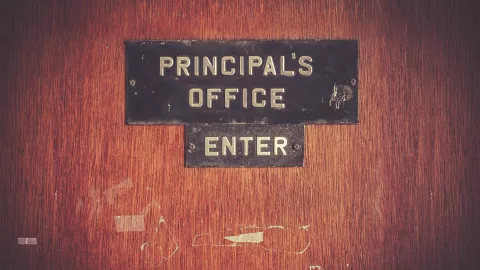Educator Well-Being: Making progress … Slowly
The 2023 State of the Teacher Project, by the Rand Corporation, contained a nugget of good news: Teachers reported better well-being in early 2023 than they did in 2022 or 2021. In addition, job-related stress has returned to pre-pandemic levels. But stress levels are still higher than other working adults. More teachers reported access to at least one type of well-being or mental health support in 2023 than in 2022, but only slightly more than half of all teachers indicated that these supports were adequate.
Where Are the Students?
During the first two years of the pandemic, public school enrollment fell by 1.2 million. Many students transitioned into homeschooling, while others were enrolled in private school or moved out of state. But those trends cannot fully explain public school enrollment losses. An analysis by the Associated Press and Stanford University found that in the 21 states with available data, an estimated 230,000 student absences could not be explained.
“Before this research, we knew virtually nothing about where these kids went,” said Thomas Dee, a professor at the Stanford Graduate School of Education. “Now we have some really important evidence to explain a portion of that exodus. But the fact that so much of the loss cannot be explained raises new questions about what will help students get their education back on track.”
The 10 states that reported missing students (2019-2022)
Teacher Fired Under ‘Divisive Concepts’ Law

My Shadow is Purple sat on Katie Rinderle’s classroom shelf for a month, until her fifth graders chose it for their morning read-aloud. The next day, Rinderle, a teacher in Cobb County, Georgia, was called into the principal’s office. The book was “divisive,” she was told. The following week, she was sent home for good—and on June 6, she was issued a formal letter of termination, which she appealed with help from her union, the Georgia Association of Educators (GAE), and the Goodmark Law Firm.
Rinderle had read My Shadow is Purple and liked it.
“I just thought it had a wonderful message: Be true to yourself, embrace others,” she says. Essentially, the award-winning book is about finding value in yourself, which leads to self-confidence and well-being, she says.
For gifted students especially, who often feel different and excluded from their peers, it’s heartening to hear a story about valuing and embracing the differences in people, Rinderle says.
Rinderle is believed to be the first teacher in Georgia to have been fired because of a trio of vaguely worded 2022 state laws that ban teachers from teaching “divisive concepts.”
Educators fear she won’t be the last, which is likely the point of the Georgia legislation and similar classroom censorship laws in other states.
“Teachers are fearful of [crossing] the invisible line in their classrooms … because they don’t know where it is,” Rinderle says. So, they self-censor, pulling books from their shelves and shutting down student discussions. Or they just quit.
The consequence is a grim and limited education for students, who are experiencing less access to dedicated teachers, diverse books, and honest and accurate history lessons.
Together, many of these parents are working with NEA members to get diverse books back into the hands of teachers and enable students to learn about what NEA President Becky Pringle calls, “the history, beauty, and diversity of their world.”
Learn more about how you can demand an inclusive, culturally responsive public education system.

CROWN Act Gathers Momentum

An important turning point for racial and social justice took place on July 3, 2019, when California Gov. Gavin Newsom signed the CROWN Act (Creating a Respectful and Open World for Natural Hair Act) into law, which legally protects people in workplaces and children in K–12 public schools from discriminatory grooming policies. African Americans have historically experienced discrimination based on their hair. The CROWN Act protects certain hairstyles, such as afros, braids, twists, cornrows, and locs. Since then, the movement to prohibit race discrimination based on hair has gained momentum across the nation. Today, 23 states have adopted versions of the CROWN Act, with Michigan and Texas signing the two most recent laws this summer.
Racial Gaps in Discipline Driven by Small Number of Teachers

Office Discipline Referrals (ODRs)—or visits to the principal’s office—are typically the first formal step in the school discipline process. More formal consequences, including suspension, can soon follow.
A team of researchers at the University of Maryland and the University of California, Irvine, explored the role these referrals play in perpetuating racial disparities in exclusionary school discipline. Drawing on data from a large, diverse urban district in California, what the researchers discovered surprised them: A small group of teachers engaged in extensive referring, effectively doubling the racial gaps in such referrals.
The top 5 percent of referring teachers issued an average of more than 48 ODRs per year—roughly one ODR every four school days. Top referrers—who tend to be White and early in their career—accounted for 34.8 percent of all ODRs.
The study also found that referrals issued for subjective reasons, such as “interpersonal offenses and defiance”—as opposed to more objective reasons, like violence or drug use—were largely responsible for the increase in racial gaps.
“Given that top referrers tend to be teachers early in their careers, targeting professional development supports of classroom management skills for this group of teachers might also be a viable approach to reducing their referring frequency,” said study co-author Jing Liu. “Our analysis highlights that structural supports at certain school levels are warranted.”
Doesn’t Anyone Read for Fun Anymore?
The National Assessment of Educational Progress (NAEP) report released in June showed a disturbing decline in reading scores among 13-year-olds. While that news sparked more concerns about the pace of learning recovery from pandemic-era virtual learning, the NAEP report, or the “Nation’s Report Card,” contained another finding that should alarm educators and parents everywhere. In a separate survey, only 14 percent of students said they read for fun every day. That’s down 3 percentage points from 2020, and 13 percentage points since 2012. In 1984, 35 percent of students reported reading for fun almost daily.


